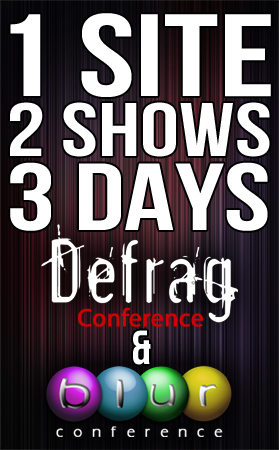Yesterday, Krish Subrmanian asked on Twitter: “Why is @adrianco talking at Defrag? Shouldn’t he be at Gluecon? cc: @defrag #justwondering #didimissthetheme?” “Adrianco” is Adrian Cockcroft, cloud architect at Netflix, and I’ve asked him to come keynote at Defrag. Krish is a bit confused because, historically, this would be a Gluecon talk - hence the question. All of that has led to this post — namely, me thinking that I should explain my thoughts a bit around this year’s Defrag.
Five years ago, Defrag was created because of a fairly simple email exchange between myself and Brad Feld. It went something like this:
Me: “That blog post you wrote would make a great conference. We should start one.”
Brad: “I hate conferences. So, yep, let’s do one that’s not like the rest. I’m in.”
And Defrag was off and running.
Now, initially, Defrag was trying to address a specific topic — namely, information overload and the “implicit web.” I quickly realized that included a bunch of other topics — things like the semantic web, collaboration technologies, and this new topic that was emerging, “enterprise 2.0.”
Year’s two and three of Defrag saw us focus more on the e2.0 theme — with two important developments: 1) in year 2 (2008), we firmly focused in on the fact that social media and e2.0 were two sides of the same IT coin — even if there wasn’t a a good name for it; that name would, of course, eventually become “social business”; 2) in year 3 (2009), we came to realize that mobile and the “appification” of things (via app marketplaces, etc) would rise to prominence, and that, accordingly, APIs were a central component in this ecosystem.
With every passing year, we found ourselves learning SO much from our attendees (really, they’re more like participants) that we were beginning to see 18-24months in advance of when everyone else would see it (Defrag has correctly predicted every product and other conference topic trend out there), while simultaneously, our attendees were dragging us away from being “tethered” to any one topic.
Now, one thing I know from 10 years of running conferences is that there are two types of shows (I’m over-generalizing of course): 1) shows that are attached to a topic and essentially die when the topic dies (normally, a 7 year run); 2) shows that are untethered from a topic and can talk about anything they want because they’ve developed a fanatical community (examples: PC Forum, TED, or even Agenda — if you’re old enough to remember that one).
By year four, I knew that I didn’t want Defrag to be too tightly tied to the e2.0 theme — because I know that theme will die (and take down the e2.0 shows with it) in time, and I was getting that feeling the Defrag could be the kind of community that lasts 8, 10, maybe even 15 or 20 years. Simultaneously, we were getting HUGE amounts of feedback from our attendees -and they were saying this loud and clear: “we don’t come here for the topic focus. we come here to have our minds opened up; to see the new possibilities; to hear about what’s around the corner and over the horizon. surprise us with your topics.” So, in year four, I began to do just that — talks by folks like Paul Kedrosky and Jeff Jonas began to address topics that were decidedly not tied solely to a topic. And guess what — people LOVED it. I mean, overjoyed, hop out of their seats, loved it. The single most common thing I heard post-Defrag year 4 was “you’re like TED, but cheaper.” And THAT was a huge compliment.
And that’s when we knew we had to do two things:
1) Limit our size: Defrag was growing every year, but last year I felt like we had crossed a line that was just a *touch* too big. So this year, we’re purposefully making it smaller (by about 10%) and capping attendance. Quality of conversation, not quantity of booth traffic - that’s our game. The other guys can give away all of the expo passes they want, it’s not what we do, it’s not who we are. People that actually come to Defrag love it, and tend to always come back (our return attendee rate is huge).
2) Take the leap and firmly un-tether from a “topic” at the Keynote level.
So, what does number 2 mean?
Kim and I were on a 16 hour drive to Florida when we sketched the outline of Defrag’s 5th year agenda. What we came up with was simple: The show needed to *focus* on the single-track keynote room. We knew that enthusiasm laid in having everyone together for the great majority of the show. As such, we’ll have 25-30 people on the keynote stage over 2 days, where 20 of those keynotes are 30 minutes in length. We’ll also have one hour per day of 3 wide breakouts that will explore more deeply some of the topics near and dear to our sponsor’s hearts.
Lastly, no panels. None. Zero. Not one. At Defrag, you speak solo, or you don’t speak. You carry the stage by yourself, or you don’t get on the stage. The quality bar is going up. Every keynote speaker was getting measured by the “kedrosky/jonas” bar.
What does this mean topically? On the keynote stage at this year’s Defrag, you’re apt to hear strategic level talks about everything from patents to culture’s of agility to tech and finance to mobile to cloud computing to APIs to enterprise 2.0 to collaboration to big data to social media to education and tech to community management to enterprise trends to startup culture to gamifcation. In the breakouts, you’ll hear more about specific topics (activity streams, real-time collaboration, email plugins, etc).
At the end of the day, Defrag is going to embrace what our community is telling us we already are — a completely unique experience that brings a level of intimacy, participation and thoughtful conversation that is unmatched and unrivaled by any other tech conference on the planet (yes, the planet; i’m aiming for inter-galactic domination in year’s 15 thru 20 of defrag).
If you’ve never been, seats are very limited. If you have been, I can’t wait to show you how we’re going to exceed your expectations this year. ![]()
(P.S. We’re just getting started on the keynote side, and have some amazing announcements coming - stay tuned.)
Side-note: Don’t kid yourself, this decision directly impacts the future of this business. When we choose to cap attendance and focus on fostering a community that wants to come back for 15 years straight, we are purposefully saying this is not about the money we make. Conferences scale up profits by scaling up size. When you go to a 1000, 1500, 2000, 13,000 person conference as an attendee, YOU are the product being sold. The organizers sell size to the sponsors because “booth traffic” means “sales leads.” This isn’t to say that our sponsors don’t want sales leads - of course, they do. But know that this choice by us means that our community is our customer, not our product - and that’s not the case elsewhere (it can’t be, just by the nature of the business model chosen).

